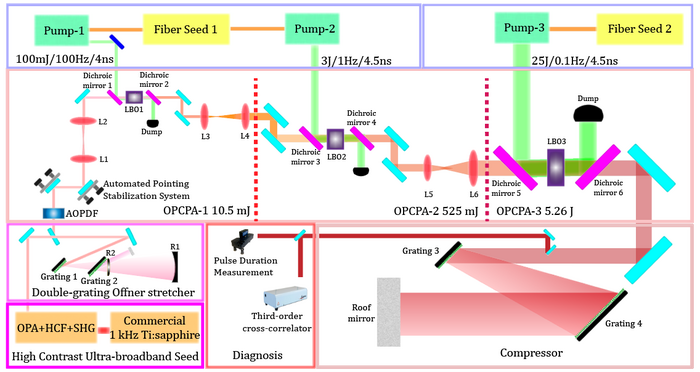Ultra-high intensity, ultrafast femtosecond lasers, with peak powers at a level of 10 petawatt (PW) or even higher, have led to the generation of unprecedented extreme physical conditions in laboratories, which pave new ways to the long-standing pursuit of fundamental science and the promising applications. The 100 PW laser system as the core machine of the Station of Extreme Light (SEL) which is one of the stations of Shanghai High repetition rate XFEL and Extreme light facility (SHINE), is being developed and scheduled to be ready in 2025. Here, we describe the recent progress of the front end used in SEL-100 PW laser facility.

Credit: Ultrafast Science
Ultra-high intensity, ultrafast femtosecond lasers, with peak powers at a level of 10 petawatt (PW) or even higher, have led to the generation of unprecedented extreme physical conditions in laboratories, which pave new ways to the long-standing pursuit of fundamental science and the promising applications. The 100 PW laser system as the core machine of the Station of Extreme Light (SEL) which is one of the stations of Shanghai High repetition rate XFEL and Extreme light facility (SHINE), is being developed and scheduled to be ready in 2025. Here, we describe the recent progress of the front end used in SEL-100 PW laser facility.
In the front end, a 5.26 J / 0.1 Hz amplified output with a bandwidth over 200 nm near the center wavelength of 925 nm has been realized by our team, using 3 stages of optical parametric chirped-pulse amplification (OPCPA) based on lithium triborate (LBO) crystals (Figure. 1). After the compressor, we obtained a pulse duration of 13.4 fs by carefully dispersion compensation (Figure. 2). This OPCPA front end could potentially support a peak power of 263 TW at a repetition rate of 0.1 Hz. To the best of our knowledge, among all the 100-TW-level OPCPA systems, it shows the widest spectral width, the shortest pulse duration and it is also the first OPCPA system working at a repetition-rate mode.
In the next stage, this front end, which can be regarded as a small prototype of the SEL-100 PW facility, will serve as the test platform for key technologies and optical components of the unique laser. The SEL-100 PW facility will open to users after being completed, and it can provide a focused beam intensity of more than 1023 W/cm2. This laser will work with a hard X-ray for pump–probe experiments, such as experimentally verifying the vacuum birefringence phenomenon.
Journal
Ultrafast Science
DOI
10.34133/2022/9894358
Method of Research
Experimental study
Subject of Research
Not applicable
Article Title
13.4 fs, 0.1 Hz OPCPA Front End for the 100 PW-Class Laser Facility
Article Publication Date
18-Oct-2022




